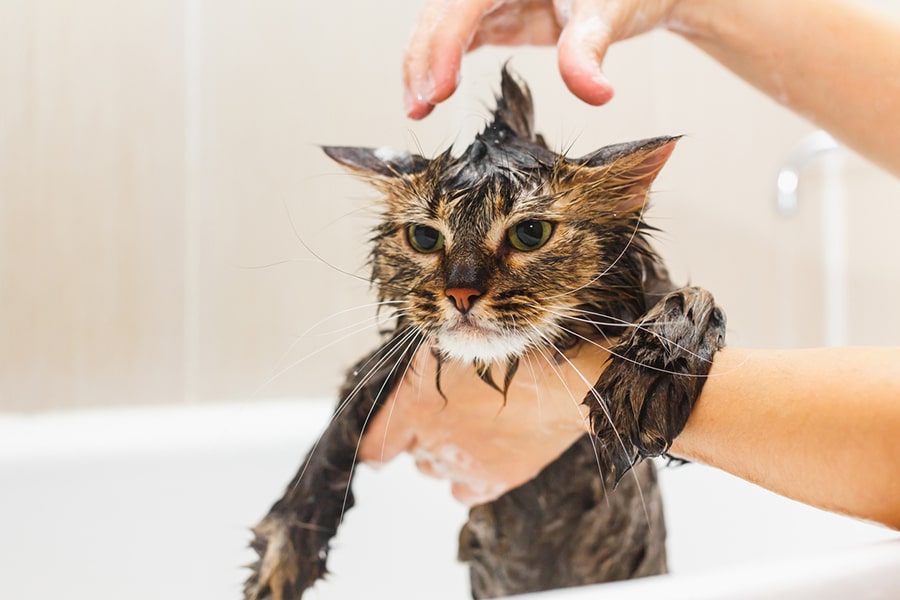Wrinkly Dog Care Tips
Wrinkly dogs require a little bit of extra cleaning and grooming. Check out some helpful tips on how to keep your dog’s wrinkles squeaky clean.
Bathe my cat? You have to be kidding me, right? Those were my first thoughts when my cat Zoe tried to climb up the chimney and came down a sooty mess. Luckily, she wasn't injured, but it certainly wasn't safe for her to lick off all of those ashes, so into the sink she went. Somehow I survived and lived to tell the tale!
Fortunately for you and your cat, our feline friends don't need regular baths like their doggie counterparts. (By the way, if you do have a canine in the house, you should check out these tips on how to bathe your dog.) Cats are typically fine bathing and grooming on their own by using their rough tongues to clean and smooth their coat. Of course, this can produce some icky hairballs, but that's another hairy story.
However, there are times when a cat needs to be washed with water. Yes, I said it. With water. Obviously, my poor sooty Zoe required a bath after her trip up the chimney. Some of you may even be asking yourself, "Is it safe to give a cat a bath?" Yes, indeed it is. In fact, cats may need a good washing for a number of reasons. For instance, if they:
Curiously enough, many of their wildcat relatives really enjoy a dip in the water. There is no better place for big cats like lions, jaguars, and tigers, who live in hot environments, to cool off. So why do our domesticated felines seem to hate it so much? It might be that they're just not used to the whole experience of being held in a sink or tub and getting drenched. Their coats can also take a while to dry out, which can make them cold and uncomfortable.

OK, here it is, folks—the step-by-step survival guide to giving your cat a bath based, in part, on my personal experience. And if you're wondering how to bathe a cat without getting scratched, unfortunately, I can't offer any scratch-free guarantees!
Be sure you have everything you need on hand before you get your cat wet. I can't emphasize this enough. It will make bath time go faster, which is a good thing for both you and your cat. Plus, you'll avoid the awkward situation of desperately calling out for a towel while you try to keep your sudsy cat calm and still.
Here's what you need:
You can bathe your cat in the sink or bathtub, depending on their size. The sink may be easier since you don't have to kneel or bend down. You can also purchase a plastic tub from a pet store to get the job done.
If you use a sink or tub, you might also want to purchase a non-slip mat to help keep your cat from getting hurt.
All set? Great! Now you can get washing. Just follow these 5 simple steps:
When you're done, wrap the towel gently around your cat and lift them out of the sink or tub. Time to breathe a big sigh of relief!
Now that the bath is over, you'll need to dry your cat off with the towel, so they won't be uncomfortable or get cold. Cats and hairdryers typically don't make a good combination. However, if you have a longhaired breed that needs some assistance drying off (and you're really brave!), you can try a hairdryer.
Lots of cats will be terrified by the noise of a hairdryer. If that's the case, turn it off immediately and stick to the towel. You should also only use a low heat setting or a dryer made for pets, which will be cooler. You've likely both gotten this far unscathed, and you certainly don't want to risk burning your cat at this stage of the game.

There isn't much difference between bathing a kitten and a cat, although young furballs can be more playful and harder to keep still. If your kitten thinks bath time is playtime, you can try to distract them with a toy or small treat. Those rubber gloves are especially important for bathing a kitten since they may try to nip at your hands playfully.
One last kitten tip—be sure to consider your tiny friend's size. A sink or small store-bought tub will probably work better for a kitten than a larger tub. You don't want your kitten to feel overwhelmed in a cavernous space or have that much room to move around and possibly get hurt.
Bath time will likely (and hopefully!) be a rare occurrence, but there are some grooming you can assist with on a regular basis to help keep your cat looking and feeling pretty:
A healthy coat is also a product of a healthy cat. Be sure to take your cat to the veterinarian for an annual check-up. Also, take care of those pearly whites with yearly dental exams and regular tooth brushing at home. Yes, it can sound as daunting as bathing, but it's a must!
Have a dog at home as well? Check out these grooming tips for them, too!
If you've read all of this and still quiver and quake at the thought of giving your cat a bath, you can always turn to a professional groomer. Some groomers will even come to your home to wash your cat in the house or a mobile grooming van. Your veterinarian can also offer advice if you want to do it yourself but don't feel confident enough to take on the task.
Wishing you the best of luck in your cat bathing efforts! Remember, I survived, and you can too.
The information presented in this article is for educational and informational purposes only and does not constitute or substitute for the advice of your veterinarian.